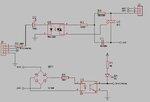abuhafss
Full Member level 2

Hi
Recently working on an Arduino based AC heater controller, I have been facing some unusual problems with MOC3020 and triacs BTA136 or BTA41.
Attached, please find the schematic and the completed PCB.
Initially, for testing, I connected an incandescent bulb across heater terminals and connected the FIRE pin to 5V. The bulb lit fine.
At a later stage, the bulb stopped working. I replaced the triac, nothing improved. Shorting the pins 4 & 6 of optocoupler lit the bulb. I replaced MOC3020 but still the problem is there.
Now, when I switch on 220VAC with FIRE pin already connected to 5V, the bulb would lit for a fraction of second and then go off. Same happens when I switch off 220VAC.
I shall appreciate suggestions for troubleshooting the module.
Recently working on an Arduino based AC heater controller, I have been facing some unusual problems with MOC3020 and triacs BTA136 or BTA41.
Attached, please find the schematic and the completed PCB.
Initially, for testing, I connected an incandescent bulb across heater terminals and connected the FIRE pin to 5V. The bulb lit fine.
At a later stage, the bulb stopped working. I replaced the triac, nothing improved. Shorting the pins 4 & 6 of optocoupler lit the bulb. I replaced MOC3020 but still the problem is there.
Now, when I switch on 220VAC with FIRE pin already connected to 5V, the bulb would lit for a fraction of second and then go off. Same happens when I switch off 220VAC.
I shall appreciate suggestions for troubleshooting the module.






